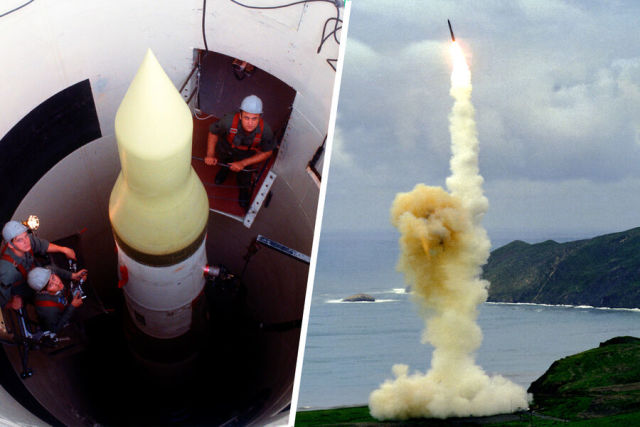Dmitry Stefanovich, a researcher at IMEMO RAS, spoke about the risks of developing a nuclear conflict
Russian and Western analysts have been discussing the possibility of using nuclear weapons since the beginning of Russia's special military operation in Ukraine. Dmitry Stefanovich, a researcher at the IMEMO RAS Center for International Security, co-founder of the Watfor project, an expert of the Russian Council on International Affairs and the Valdai Club, assessed the likelihood of an escalation of the conflict in Ukraine towards the use of nuclear weapons and told what state the nuclear triads of Russia and the United States are in, as well as what Russia's response may be if the United States places its nuclear weapons on the territory of Finland and Sweden.
- Russian Deputy Foreign Minister Sergei Ryabkov expressed hope that the United States would not use nuclear weapons because of the Russian operation in Ukraine. Can the Ukrainian events escalate into a nuclear conflict?
- The threat of the use of nuclear weapons always exists - from the moment of its appearance and, apparently, until the "nuclear zero" is reached, if it ever happens. In the context of his thesis, Sergei Ryabkov looks like a fairly high-quality "prick" of Western partners who are constantly talking about crazy scenarios of the use of nuclear weapons by Russia in connection with hostilities on the territory of Ukraine. At the same time, of course, there are several very real escalation scenarios associated with the possible involvement of third countries in the conflict and its transition to a regional or even global level, which may create conditions for the use of nuclear weapons.
- As for the use of tactical nuclear weapons - can they be used in Ukraine after hypersound, given the growing escalation of the conflict?
- It is interesting that you mentioned hypersonic weapons as a kind of separate escalation stage. Despite the fact that, in fact, this is only one of the types of high-precision long-range weapons that can have both nuclear and non-nuclear equipment, the opinion about its "intermediate" nature between conventional and nuclear weapons is quite widespread. At the same time, as far as nuclear weapons themselves are concerned, there is not a single target task that it would allow to solve (and conventional weapons could not) without creating a whole bunch of new problems.
- What is the current state of the nuclear triads of Russia and the United States?
- Nuclear triads are being modernized both in Russia and in the USA, although in the case of Russia we have rather the final stage: the rearmament of the corresponding missile divisions on the "Yars" is being completed, the process of setting up the deployment of the Avangard missile complex with a hypersonic gliding cruise unit is underway, tests of the heavy Sarmat ICBM have begun, the advanced stage is modernization of combat control systems, as well as infrastructure (although not without drawbacks and delays, as usual).
In terms of the maritime part of the triad, we can talk about the increasingly significant role of the new strategic missile submarines of the Borey family with the Bulava missile, while maintaining the Blue and Liner missiles on combat duty on submarines of the 667BDRM project.

Dmitry Stefanovich
Image source: imemo.ru
The aerial "leg" is still based on deeply modernized Tu-95MSM and Tu-160M bombers, and, as far as can be judged, the restoration of production of the latter is still successful.
At the same time, the X-102 cruise missile for aviation strategic nuclear forces is probably the most advanced product of this class in the world, and certainly the most modern. We have also launched a project to modernize long-range Tu-22M3 bombers into the "M3M" version, which, theoretically, can lead to an "upgrade" of their class to strategic carriers - including according to the classification of the current DSNV. At the same time, the project of the promising PAK DA bomber is progressing rather slowly, and it is difficult to judge its fate yet. It is also impossible not to mention the "exotic" means of delivery with nuclear power plants - the Petrel cruise missile of unlimited range, an unknown type of basing, as well as the Poseidon multipurpose ocean system. For the first product, it is not necessary to make predictions about putting into service yet, for the second, the first regular carriers will probably appear within a year or two, but the degree of combat readiness of the Poseidon, as well as the priorities of this underwater drone, remain unknown. In general, it seems that these projects are in the nature of "insurance" in case of breakthrough achievements in the field of missile defense in the United States.
The Americans are also modernizing the entire triad, but it is at an earlier stage. However, if, for example, the land-based Minuteman-3 is a rather old product, and, apparently, is inferior to the Yars and its modifications (there are simply no analogues of the Sarmat and Avangard in the USA and, apparently, it is not supposed to be), then the marine Trident II remains a kind of standard of ballistic submarine missiles.
In the first case, a new Sentinel ICBM program has been launched, the appearance of which is still being worked out, in the second, a new missile is unlikely to appear on the agenda before the end of this decade, but new carriers, nuclear submarines with new-generation Columbia ballistic missiles, have already begun construction.
Discussions about the possibility of "chopping off" individual projects or even entire "legs" of the American triad, in fact, have come to naught, which is rather due not so much to tensions in relations with Russia as to the build-up of Chinese nuclear potential, noticeable to the naked eye.
- How can today's events affect the nuclear programs of Russia, the United States, the DPRK, and China?
- It is hardly possible to talk about any radical problems with nuclear programs due to sanctions, after all, the emphasis on independence is traditional in this area, and in the DPRK, in general, most of their nuclear missile achievements were carried out under the most severe sanctions pressure. Of course, some individual elements may experience difficulties, but, again, we are talking about the degree of such difficulties. A few years ago, for example, in the American media, with reference to intelligence data, it was reported about a limited supply of carbon fiber for the winged blocks of the Avangard complex - indicating that it would be enough "only" for 60 units. By all estimates, this is more than enough for a very long period of deployment of this system, even adjusted for the possible integration of such planning cruise blocks with the Sarmat missile.
At the same time, it is possible that pressure, both sanctions and other types, may push, for example, Russia and China to more and more cooperation in the strategic sphere, and the DPRK to more and more "aggressive" tests and rhetoric.
- The United States is developing a Sentinel missile to replace the Minuteman-3, it should enter service by 2029. Is this realistic, given the failures of the United States, for example, with hypersonic missiles?
- Options for upgrading the Minuteman-3 were considered and were found to be ineffective, including economically, and, again, an insufficient solution for the long term. By the way, there is even an even simpler option - to load Trident II into the existing mines after appropriate refinement. At the same time, the new Sentinel missile is still a priority option. There is no doubt that the United States is capable of this project, however, of course, as with any new strategic "product", the emergence of current problems is inevitable. But I think we should manage it in 7-8 years.
- Why has the United States not been engaged in nuclear weapons for 30 years?
- I think the main reason is the choice as a priority of what can be used in real armed conflicts, that is, conventional weapons, combined with a fairly good pace of nuclear disarmament, and in general, a relatively long period of absence of direct confrontation between the nuclear superpowers - Russia and the United States. Now the atmosphere is different, and there are more participants, including in terms of nuclear deterrence.
- It is known that the "youngest" US nuclear warhead W-88, which can be equipped with a Trident II missile, was released in the 1980s. What is the problem of creating new nuclear warheads?
- Despite the years of production, there is constant maintenance and maintenance of nuclear arsenals, all the necessary work is being modeled and, in general, hardly anyone should doubt the effectiveness of existing nuclear warheads. At the same time, a program has also been launched for a new W93 warhead (with some participation from the UK), as well as for the production of new plutonium cores ("pits") to replace existing ones. Not everything is going perfectly, in particular, the target for the production of 80 pits per year by 2030 may not be reached. But it is unlikely that this will undermine the American nuclear potential in any way, at least in the medium term.
- North Korea is preparing for nuclear tests. What do they have with their nuclear program at the moment?
- The DPRK is working to improve its nuclear weapons, both for conditional "strategic" tasks and for "tactical" ones. Delivery vehicles are being developed and improved, and, apparently, in the foreseeable future, Pyongyang will have a fairly diverse arsenal - from relatively low-power and small warheads for tactical missile systems to megaton-class thermonuclear warheads designed for ICBMs. Apparently, missiles with hypersonic planning blocks of various types will also be nuclear or dual-use. Another thing is that for the guaranteed operation of all this "economy", full-scale tests are needed, so it is unlikely that Kim and his team will let us get bored.
- Finland and Sweden are preparing to join NATO, the United States has stated that if they join the alliance, they will not guarantee the non-deployment of nuclear weapons near the borders of Russia - in Finland. What is the point of placing it close, given its range?
- The placement of nuclear weapons directly "at the line of contact" really looks rather doubtful from the point of view of military expediency. At the same time, the political signal, of course, turns out to be obvious: NATO is a nuclear alliance, and is ready to use nuclear weapons to protect its members at any stage of the conflict, which is symbolized by the presence of the corresponding potential directly "on the ground". This design is not that very elegant, but it seems to work. Another thing is that, for example, such actions will not be very compatible with the provisions of the Russia-NATO Founding Act that is still alive (although many already doubt this), as well as with the first two articles of the NPT, which Russia regularly points out.
The Russian response, as stated, will directly depend on where the situation in this area will move.
In principle, as if directly for such a case, in our "Fundamentals of State Policy in the field of nuclear deterrence" of the 2020 model, there is a separate item number 12, directly listing all those "military dangers" "for the neutralization of which nuclear deterrence is carried out."
It can be assumed that, depending on the actions of NATO, there will be a clarification of the goals, scenarios of use and geography of deployment of the Russian armed forces, and primarily in terms of non-strategic nuclear and strategic non-nuclear weapons, as well as air defense and missile defense systems.

